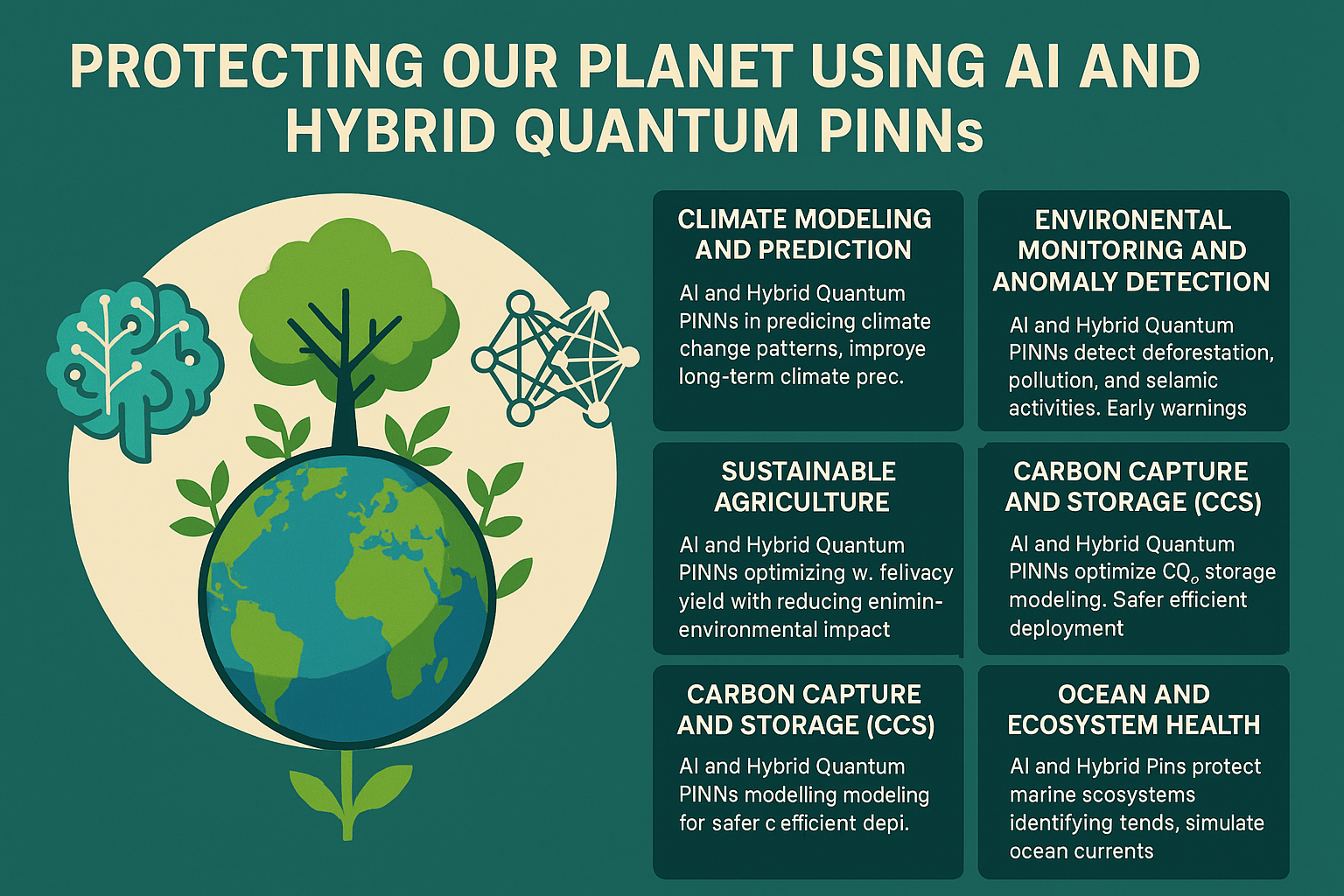What is Hybrid Quantum Physics-Informed Neural Networks (HQPINNs)?¶

Hybrid Quantum Physics-Informed Neural Networks (HQPINNs) are a novel fusion of quantum computing, deep learning, and physics-based modeling that aim to solve partial differential equations (PDEs) by leveraging both classical neural networks and quantum circuits. These models are particularly useful for problems governed by known physical laws, where data may be scarce but the governing equations are well understood.
📘 Why HQPINNs?¶
Traditional PINNs embed physical laws (like Navier-Stokes or Schrödinger equations) into the loss function of a neural network. However, as physical systems grow in complexity or enter the quantum domain, classical computation becomes a bottleneck due to issues like the curse of dimensionality and non-convex optimization.
Quantum computing offers new opportunities:
- Superposition and entanglement allow for representation of high-dimensional solutions.
- Quantum circuits can potentially speed up function approximation and optimization.
Thus, HQPINNs combine:
- Classical PINNs to capture boundary conditions and data-driven constraints.
- Quantum sub-networks (variational quantum circuits) for function representation or PDE component solutions.
- Hybrid training using classical-quantum optimizers (e.g., ADAM + SPSA or COBYLA).
🔍 Use Cases of HQPINNs¶
1. Quantum Chemistry & Materials Science¶
- Estimate ground state energies of molecules using hybrid PINN-VQE structures.
- Solve electronic structure PDEs (Schrödinger equation) with quantum components.
2. Climate Modeling and Environmental Physics¶
- Model heat transfer in climate systems more efficiently using quantum-enhanced PDE solvers.
- Simulate atmospheric dynamics governed by Navier-Stokes or advection-diffusion equations.
3. Subsurface Flow & Groundwater Modeling¶
- Solve Darcy’s law or transport equations using HQPINNs for hydrological applications.
- Predict pollutant spread and groundwater recharge under different climate scenarios.
4. Inverse Problems in Physics¶
- Infer unknown coefficients in PDEs (e.g., reaction rates, diffusivities, potentials).
- Useful for discovering unknown physics from limited experimental data.
5. Seismic Imaging and Geophysical Exploration¶
- Model elastic wave propagation to locate oil, gas, or geothermal reservoirs.
- Train HQPINNs with sparse seismic data and embed wave equations into the network.
🌍 How HQPINNs Can Help Protect Our Planet¶
✅ 1. Faster & Greener Scientific Simulations¶
Quantum-enhanced PINNs reduce computational cost and energy usage in solving large-scale simulations of climate systems, oceanography, and ecosystem models—critical for understanding environmental impacts.
✅ 2. Accurate Prediction of Natural Disasters¶
HQPINNs can help model complex geophysical systems (like earthquakes, tsunamis, or wildfires) governed by nonlinear PDEs. Better prediction leads to better preparedness and mitigation.
✅ 3. Optimizing Renewable Energy Systems¶
By solving PDEs governing wind, solar, and hydro systems, HQPINNs help optimize energy efficiency, predict supply-demand dynamics, and assist in grid integration.
✅ 4. Sustainable Agriculture¶
HQPINNs can model water transport in soil and crop ecosystems under variable climate conditions. This enables precision agriculture, conserving resources while maximizing yield.
✅ 5. Pollution Control & Resource Management¶
Modeling diffusion of pollutants in air and water using HQPINNs allows for proactive monitoring and containment strategies. These models can operate with sparse environmental sensor data by leveraging physical laws.
🔧 Technologies Used in HQPINNs¶
- Libraries: Qiskit, PennyLane, DeepXDE, PyTorch
- Quantum Circuits: Variational Quantum Circuits (VQCs)
- Optimization: Hybrid optimizers (COBYLA, SPSA, Adam)
- Backends: IBM Quantum, Rigetti, IonQ (via Qiskit/PennyLane)
- Deployment: Hugging Face, Docker, and Jupyter Books for reproducibility
🧭 Conclusion¶
Hybrid Quantum PINNs represent a paradigm shift in scientific machine learning—offering interpretable, physically consistent models with the potential to address humanity’s greatest challenges in climate change, sustainable development, and quantum science. Their development and deployment can make future computing both intelligent and sustainable.
‘’’
C. Albornoz, G. Alonso, M. Andrenkov, P. Angara, A. Asadi, A. Ballon, S. Bapat, L. Botelho, I. De Vlugt, O. Di Matteo, P. Downing, P. Finlay, A. Fumagalli, A. Gardhouse, J. Geoffrion, N. Girard, A. Hayes, J. Izaac, R. Janik, T. Kalajdzievski, A. Kanwar Singh, A. Khomchenko, N. Killoran, I. Kurečić, O. Landon-Cardinal, A. Martin, D. Nino, A. Otto, C. Pere, J. Pickering, K. Renaud, J. Soni, D. Wakeham, L. Young. PennyLane Codebook. 2024. https://
pennylane .ai /codebook